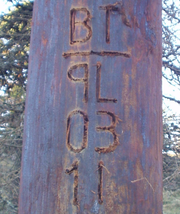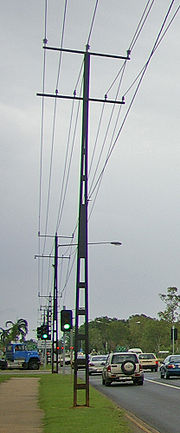Utility pole
From Wikipedia, the free encyclopedia
| This article may require cleanup to meet Wikipedia's quality standards. Please improve this article if you can. (July 2008) |
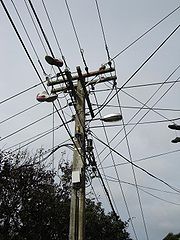
A utility pole, alternately referred to as a power pole, telephone pole, telegraph pole or telegraph post, is a (usually wooden) pole used to support overhead wire, cable, fiber optic cable, transformers, street lights and other overhead lighting, and related and unrelated equipment including signage. A single pole is often used to support both electric power distribution lines and telecommunications cables, as well as their associated equipment. Wire and cable are routed overhead as a relatively inexpensive way to keep them insulated from the ground and each other, and out of contact with pedestrians or vehicles. Utility poles were first used in the mid-1800s with telegraph systems.
[edit] Use
Utility poles are commonly used to carry two types of electric power lines, [1] Distribution lines (or "feeders") and subtransmission lines. Distribution lines carry power from local substations to customers. They generally carry voltages from 4.6 to 33 kilovolts (kV) for distances up to 30 miles, and include transformers to step the voltage down to one suitable for use by customers, the "mains voltage". Service drops connect to this lower voltage line and run to customers premises. Subtransmission lines carry higher voltage power from regional substations to local substations. They usually carry 46 kV, 69 kV, or 115 kV for distances up to 60 miles. Higher voltage transmission lines are usually not supported by poles, but by metal pylons. For economic or practical reasons, such as to save space in urban areas, a distribution line is often carried on the same poles as a subtransmission line, but mounted under the higher voltage lines, a practice called "underbuild". Telecommunication cables are usually supported by the same poles that support the power lines, but may have their own dedicated poles.
[edit] Description
Different length poles, up to 120 feet (36.6 m) or more, are used to satisfy clearance requirements, but the standard utility pole in the US is about 40 feet (12.2 m) long and is buried about 6 feet (1.8 m) in the ground, for a height above ground of about 34 feet (10.4 m).[2] They are spaced about 125 feet (38 m) apart. Joint use poles are usually owned by one utility, which leases space on it for other cables. In the USA the National Electrical Safety Code, published by the IEEE, sets the standards for construction and maintenance of utility poles and their equipment.
[edit] Material
Most utility poles are made of wood, pressure-treated with some type of preservative for protection against rot, fungi and insects. Southern Yellow Pine is the most widely used species in the United States, however many species of long straight trees are used to make utility poles, including Douglas fir, Jack Pine, Lodgepole Pine, Western Red Cedar and Pacific Silver Fir. Traditionally the preservative used was creosote, but due to environmental concerns, alternatives such as pentachlorophenol, copper naphthenate and borates are becoming widespread in the US. For over 100 years the American Wood Protection Association (AWPA) has developed the standards for preserving wood utility poles. Despite the preservatives, wood poles decay and have a life of approximately 25-50 years, depending on climate and soil conditions, therefore requiring regular inspection and remedial preservative treatments[3][4][5]. Other common utility pole materials are steel and concrete, with composites (fibreglass) also becoming more prevalent.
[edit] Access
In some countries, for example the UK, utility poles have sets of brackets arranged in a standard pattern up the pole to act as hand and foot holds so that maintenance and repair workers, known as linemen, can climb the pole to work on the lines. In the USA such steps have been determined a public hazard and are no longer allowed on new poles carrying electricity. Linemen may use climbing spikes called gaffs to ascend wood poles without steps on them. In the UK boots fitted with steel loops that go around the pole (known as “Scandinavian Climbers”) are also used for climbing poles. In the USA, for the vast majority of poles that are accessible by vehicle, linemen work out of "bucket trucks".
[edit] Power distribution wires and equipment
On poles carrying both, the electric power distribution lines and associated equipment are mounted at the top of the pole above the communication cables, for safety. The vertical space reserved for this equipment is called the "supply space".[2] The wires themselves are usually uninsulated, and supported by insulators, commonly mounted on a horizontal crossarm. Power is transmitted using the three-phase system, with three wires, or phases, labeled "A", "B", and "C". Subtransmission lines comprise only these 3 wires, plus often an overhead ground wire (OGW), sometimes called a "static line". The OGW acts like a lighting rod, providing a low resistance path to ground thus protecting the phase conductors from atmospheric static discharges.
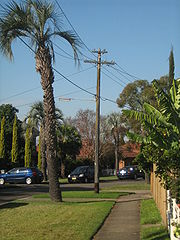
Distribution lines use two systems, either "grounded-wye" ("Y" on electrical schematics) or "delta" (Greek letter Delta, "Δ", on electrical schematics). A delta system requires only a conductor for each of the three phases. A grounded-wye system requires a fourth conductor, the "neutral", whose source is the center of the "Y" and is grounded. However, "spur lines" branching off the main line to provide power to side streets often carry only one or two phase wires, plus the neutral. A wide range of standard distribution voltages are used, from 2,400 V to 34,500 V, but the most common are 7,200 and 14,400.[citation needed] On poles near a service drop, there is often a cylindrical pole-mounted "step-down" transformer to provide the required mains voltage, usually 240/120 V "split-phase" for residential and light commercial service in the US. The transformer's primary is connected to the distribution line through protective devices called "fused cutouts". In the event of an overload, the fuse melts and the device pivots open to provide a visual indication of the problem. They can also be opened by linemen using a long insulated rod called a hot stick to disconnect the transformer from the line.
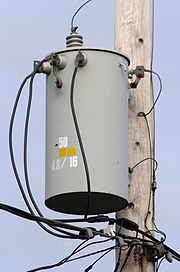
Each pole is grounded with a heavy bare copper wire running down the pole, attached to the metal pin supporting each insulator, and at the bottom connected to a metal rod driven into the ground. This provides a path for leakage currents across the surface of the insulators to get to ground, preventing the current from flowing through the wooden pole, which could cause a fire or shock hazard.[2][1] It provides similar protection in case of flashovers and lightning strikes. A "surge arrester" (also called a "lightning arrester") may also be installed between the line (ahead of the cutout) and the ground wire for lightning protection. The purpose of the device is to conduct extremely high voltages present on the line directly to ground.
[edit] Communication cables
The communications cables are attached below the electric power lines, in a space about the pole designated the "communications space".[2] It is separated from the lowest power wire by the "communication worker safety zone", which provides room for workers to maneuver safely while servicing the communication cables, avoiding contact with the power lines. The most common communication cables found on utility poles are copper or fiber optic cables for telephone lines and coaxial cables for CATV or "cable TV". Broadband internet access is also commonly provided over telephone (DSL) and/or CATV cables. The cable linking the telephone exchange to local customers is a thick cable containing hundreds of twisted pair subscriber lines lashed to a thin supporting cable. Each twisted pair line provides a single telephone circuit or "local loop" to the customer. Cables interconnecting telephone exchanges have mostly been replaced by fiber optic cables in the US. Like electrical distribution lines, communication cables connect to service drops when used to provide local service.
[edit] Other equipment
Utility poles may also carry other equipment such as streetlights, supports for traffic lights and overhead electric trolley wires, and cellular network antennas.
[edit] Dead end poles
The poles at the end of a straight section of utility line, where the line ends or angles off in another direction, are called dead end poles. These must carry the lateral tension of the long straight sections of wire. The wooden crossarms of these poles are doubled to provide more strength, and the power lines are attached to them by horizontal strain insulators.
Dead end and other poles that support lateral loads have guy wires to support them. These are steel cables attached near the top of the pole, running diagonally to an anchor buried in the ground. The guys always have strain insulators inserted in their length, to prevent any high voltages caused by electrical faults from reaching the lower portion of the cable that is accessible by the public. Another means of providing support for lateral loads is a 'push brace' pole, a second shorter pole that is attached to the side of the first and runs at an angle to the ground.
[edit] History
In 1844, Congress granted Samuel Morse $30,000 to build a 40 mile telegraph line between Baltimore and Washington. Morse began by having a lead sheathed cable made. After laying seven miles underground he tested it. He found so many faults with this system that he dug up his cable, stripped off its sheath, bought poles and strung his wires overhead. On February 7, 1844, Morse inserted the following advertisement in the Washington newspaper: "Sealed proposals will be received by the undersigned for furnishing 700 straight and sound chestnut posts with the bark on and of the following dimensions to wit: 'Each post must not be less than eight inches in diameter at the butt and tapering to five or six inches at the top. Six hundred and eighty of said posts to he 24 feet in length, and 20 of them 30 feet in length.' One of the early Bell System lines was the Washington-Norfolk line which was for the most part, square sawn tapered poles of yellow pine probably treated to refusal with creosote. Some of these were still in service after 80 years. [6]
However in the countries of Eastern Europe, in Russia and in countries of the third world, there are still many utility poles carrying bare wires mounted on insulators not only along railway lines, but also along roads and sometimes even in urban areas. Errant traffic being uncommon on railways, their poles are usually less tall. In the United States electricity is predominately carried on unshielded aluminum conductors wound around a solid steel core and affixed to rated insulators made from glass, ceramic, or poly. Telephone, CATV, and Fiber Optic cables are generally attached directly to the pole without insulators.
In the UK, much of the rural electricity distribution system is carried on wood poles. These normally carry electricity at 11 or 33kV (three phases) from 132kV substations supplied from super pylons to distribution substations or pole mounted transformers. The conductors on these are bare metal connected to the posts by insulators. Wood poles can also be used for LV distribution to customers.
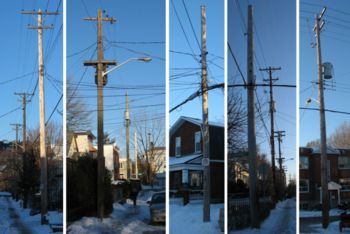
Today utility poles may hold much more than the uninsulated thin copper wire that they originally supported. Thicker cables holding many twisted pair lines or coaxial cable or even fibre-optics may be carried. Simple analogue repeaters or other outside plant equipment have long been mounted against poles, and often new digital equipment for multiplexing/demultiplexing or digital repeaters may now be seen. In many places, as seen in the illustration, providers of electricity, television, telephone, street lighting, traffic signals and other services share poles, either in joint ownership or by renting space to each other. Such poles provide a safe gap between power lines on top and signal wires below. In the United States ANSI standard 05.1-2002 governs wood pole sizes and strength loading. Utilities that fall under the Rural Electrification Act must also follow the guidelines set forth in RUS Bulletin 1724E-150 [7] (from the U.S. Department of Agriculture) for pole strength and loading.
Steel utility poles are becoming more prevalent in the United States as improvements in engineering, and corrosion prevention coupled with lowered production costs. However, premature failure due to corrosion is a concern when used in place of wood.[8] The National Association of Corrosion Engineers or NACE is developing inspection, maintenance, and prevention procedures similar to those used on wood utility poles to identify and prevent decay.
[edit] British Telecom telegraph post markings
British Telecom posts are usually marked with the following information:
- 'BT' - to mark it as a British Telecom UK Post
- a horizontal line marking 3 metres from the bottom of the post
- the pole length and size (eg. 9L implies a 9 metres long, light post)
The date on the pole is put on by the manufacturer and refers to the date the pole was "preserved" (treated to withstand the elements usually by using creosote).
In the United States utility poles are marked with information concerning the manufacturer, pole height, ANSI strength class, wood species, original preservative, and year manufactured[9] (vintage) in accordance with ANSI standard 05.1-2002 [10] this is called branding as it is usually burned into the surface. Although the position of the brand is determined by ANSI specification it is essentially just below "eye level" after installation. A general rule of thumb for understanding a poles brand is the Manufacturers name or logo at the top with a 2 digit date beneath (sometimes preceded with a month). Below the date is a 2 character wood species abbreviation and 1 to 3 character preservative. This is an incomplete list of species abbreviations:
- SP Southern Pine
- LP Lodge Pole
- WC Western Cedar
- DF Douglas Fir
Here is a list of common preservative abbreviations:
- C Creosote
- P Penta
- CCA Chromiated Copper Arsenic
X was sometimes used during WWII era to indicate creosote diluted due to shortages and/or rationing
The next line of the brand is usually the poles the ANSI Class used to determine maximum load (this number ranges from 10 to H6 with the smaller the number the greater the strength. The poles height (from butt to top) in 5 foot increments is usually to the right of the class separated by a hyphen although it is not uncommon for older brands to have the height on a separate line. The pole brand is sometimes an aluminum tag affixed by nail to the pole. Prior to the practice of branding many utilities would set a 2 to 4 digit date nail into the pole upon installation. These nails are considered extremely valuable to collectors (Please note that date nails and all other attachments on a utility pole are private property and removal/theft is a felony), with older dates being more valuable and unique markings such as the utilities name also increasing the value. The practice of date nails went out of general use during WWII due to war shortages. However, the practice is still used by a few utilities.
[edit] Coordinates on pole labels
In some areas, utility pole name plates may provide valuable coordinate information: a poor man's GPS. [11] [12]
In other especially rural areas, even their simple sequential numbering still excels the local house numbering system in providing a means of communicating location information: "Turn left at Williams Main Line #43. My house is at pole #43-Left-7."
Of course, not all power lines follow the road.
In East Anglia, EDF Energy Networks often add the Ordnance Survey Grid Reference coordinates of the pole or substation to the name sign.
[edit] Pole route
A pole route refers to a telephone link or electrical power line between two or more locations by way of an overhead cable suspended on wooden utility poles. This method of link is common especially in rural areas where burying the cables would be expensive. Another situation in which pole routes were extensively used were on the railways to link signal boxes. Traditionally (prior to around 1965) pole routes were built with open wires; this necessitated insulation when the wire passed over the pole, thus preventing the signal from becoming attenuated. To do this, cables were separated using spars with insulators spaced along them; in general four insulators were used per spar. Two such pole routes still exist on the UK rail network, one in the highlands of Scotland, and the other between Wymondham, Norfolk and Brandon in Suffolk, the latter being due for replacement in 2009.
[edit] Aerial bundled conductor
If non-insulated wires touch due to wind or fallen trees, the resultant sparks can start bushfires. To reduce this problem Aerial bundled conductors are being introduced.
[edit] Notes
- ^ a b Grigsby, Leonard L. (2001). The Electric Power Engineering Handbook. USA: CRC Press. ISBN 0849385784. http://books.google.com/books?id=wiv1tuMDbTEC&pg=PT1346&lpg=PT1346&dq=%22utility+transformer%22&source=web&ots=XwZnFMsRK8&sig=68TttGd59rC3_TstnrUd8hvXUHI&hl=en&sa=X&oi=book_result&resnum=5&ct=result#PPT385,M1.
- ^ a b c d "What's on a utility pole?". Consumer Assistance. Florida Public Service Commission. 2008. http://www.psc.state.fl.us/consumers/utilitypole/en/AllUtilityPoleInfo.aspx. Retrieved on 2008-10-24.
- ^ http://www.pmcpole.com/cms/AWPA_poleMaintenance_paper.pdf
- ^ http://www.pmcpole.com/cms/groundlineTreatmentSP.pdf
- ^ http://www.pmcpole.com/cms/rus_bulletin_1730B_121.pdf
- ^ " American Wood Preservers' Association 1978 Pole Maintenance-Its Need and Its Effectiveness James A. Taylor Timber Products Specialist Rural Electrification Administration U.S. Department of Agriculture Washington, D.C.
- ^ http://www.usda.gov/rus/electric/bulletins.htm
- ^ http://www.pmcpole.com/cms/CorrosionManagementDocument.pdf
- ^ http://www.pmcpole.com/cms/AWPAPoleBrands.pdf
- ^ http://www.ansi.org/
- ^ http://wiki.osgeo.org/wiki/Taiwan_Power_Company_grid
- ^ "Understanding coordinates on utility pole numbers". http://jidanni.org/geo/taipower/index.html. A Taiwan Power Company example; zh:電力座標
| This article needs additional citations for verification. Please help improve this article by adding reliable references. Unsourced material may be challenged and removed. (January 2008) |
[edit] See also
[edit] External links
- Lots of photographs
- Photographs of Various U.S. Utility Poles
- Hungarian Telephone Poles
- Utility Poles
- Wood Utility Pole Inspection Methods
- Wood Utility Pole Life Cycle
- A photo collection of pole routes throughout the UK and abroad
- American Wood Protection Association
- USDA Rural Development's Electric Programs
